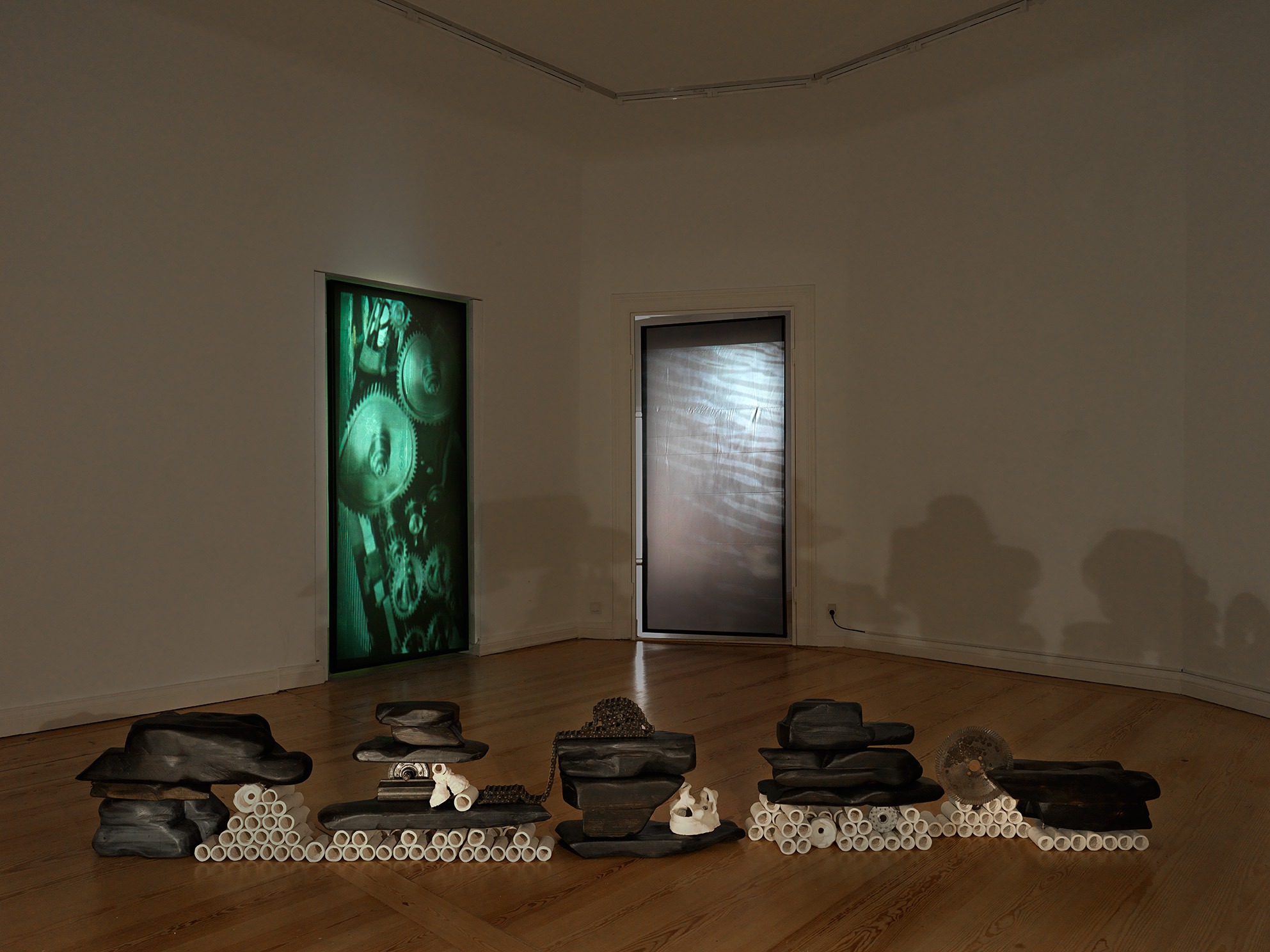Sophie Erlund
Lived Synchronicity
13 Nov - 22 Dec 2018
SOPHIE ERLUND
Lived Synchronicity
13 November – 22 December 2018
PSM is delighted to present the fourth exhibition of the Danish artist Sophie Erlund with the gallery under the title: Lived Synchronicity. The current exhibition ties in with the physical-media as well as the theoretical content of Erlund’s work to date, but in its continuation condenses the interweaving of space and sound installations, sculptures and kinetic works into a new density and depth, which activates an active and physical awareness for the viewer with all their senses.
The center piece of the exhibition and the eponymous work is the audio-video installation Lived Synchronicity. The walk-in installation consists of word play of sorts from text fragments of the essay “To Reverberate” (1936) (‘Reverberation’) by Russian philosopher Eugene Minkowski and walk-in-rear-projection-screens that visualize a 4-part video work. Minkowski and other of his contemporaries – like u.a. Gaston Bachelard, Hannah Arendt or Gilles Deleuze – have studied how images resonate, build and overlay with one another, a phenomenon we normally only know from the world of sound. In the world of sound, we know how layering can create such a massive structure that distortion eventually occurs.
Sophie Erlund places this question in an expanded form at the center of her research in Lived Synchronicity, and on this subject creates a medialized Gesamtkunstwerk in a visually perceptible context, in which images build up, reverberate, and influence one another to ultimately create distorted or reminiscent pictorial compositions in the mind ‘s eye of the observer.
All works in the exhibition relate to each other visually as well as conceptually. Wherever the viewer fixes their eye, a form, a line, a color, or a movement echoes something that you have just seen in another work a second ago. For example, the round white ceramic tubes appear time and again, weaving themselves into and out of the images and are stretched to a wild collage of images, mixed with other recognizable images such as machine parts or wood surfaces, or fine structures like hair, which then reappear as shapes of real hair on a different screen. The tubes are circles that move across the painted-leather-conveyor-belt, mixed with completely reduced shapes that relate to the black wooden bodies in the other space in the Human movement. Saw blades, chains and machine parts appear everywhere on the screens, in Human motion, as part of the conveyor belt and in the voice of the androgynous narrator, whose voice even weaves into the visual landscape in front of the visitor.
The rooms breathe, have crescendi and silence. The space is sonorous and silent at the same time. It is alive and full of movement, where even the static Human Motion sculpture appears in full forward motion. The carved imprints on the plasterboard, objects in the videos and the drawings on the leather conveyor find a rhythm and comment on this rhythm. The show is about punctuation, markers, logic and patterns;
It’s essentially about sound.
Lived Synchronicity
13 November – 22 December 2018
PSM is delighted to present the fourth exhibition of the Danish artist Sophie Erlund with the gallery under the title: Lived Synchronicity. The current exhibition ties in with the physical-media as well as the theoretical content of Erlund’s work to date, but in its continuation condenses the interweaving of space and sound installations, sculptures and kinetic works into a new density and depth, which activates an active and physical awareness for the viewer with all their senses.
The center piece of the exhibition and the eponymous work is the audio-video installation Lived Synchronicity. The walk-in installation consists of word play of sorts from text fragments of the essay “To Reverberate” (1936) (‘Reverberation’) by Russian philosopher Eugene Minkowski and walk-in-rear-projection-screens that visualize a 4-part video work. Minkowski and other of his contemporaries – like u.a. Gaston Bachelard, Hannah Arendt or Gilles Deleuze – have studied how images resonate, build and overlay with one another, a phenomenon we normally only know from the world of sound. In the world of sound, we know how layering can create such a massive structure that distortion eventually occurs.
Sophie Erlund places this question in an expanded form at the center of her research in Lived Synchronicity, and on this subject creates a medialized Gesamtkunstwerk in a visually perceptible context, in which images build up, reverberate, and influence one another to ultimately create distorted or reminiscent pictorial compositions in the mind ‘s eye of the observer.
All works in the exhibition relate to each other visually as well as conceptually. Wherever the viewer fixes their eye, a form, a line, a color, or a movement echoes something that you have just seen in another work a second ago. For example, the round white ceramic tubes appear time and again, weaving themselves into and out of the images and are stretched to a wild collage of images, mixed with other recognizable images such as machine parts or wood surfaces, or fine structures like hair, which then reappear as shapes of real hair on a different screen. The tubes are circles that move across the painted-leather-conveyor-belt, mixed with completely reduced shapes that relate to the black wooden bodies in the other space in the Human movement. Saw blades, chains and machine parts appear everywhere on the screens, in Human motion, as part of the conveyor belt and in the voice of the androgynous narrator, whose voice even weaves into the visual landscape in front of the visitor.
The rooms breathe, have crescendi and silence. The space is sonorous and silent at the same time. It is alive and full of movement, where even the static Human Motion sculpture appears in full forward motion. The carved imprints on the plasterboard, objects in the videos and the drawings on the leather conveyor find a rhythm and comment on this rhythm. The show is about punctuation, markers, logic and patterns;
It’s essentially about sound.

